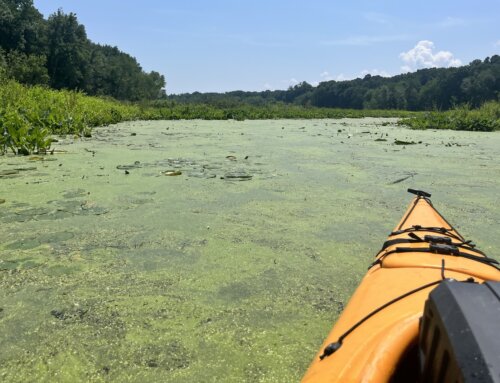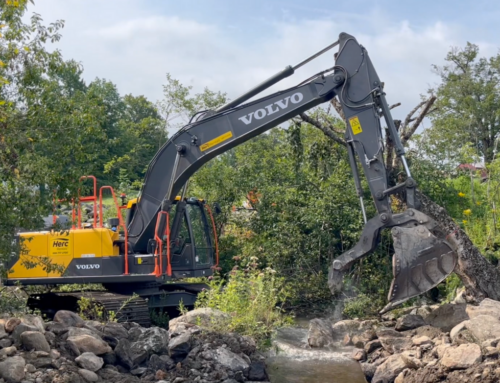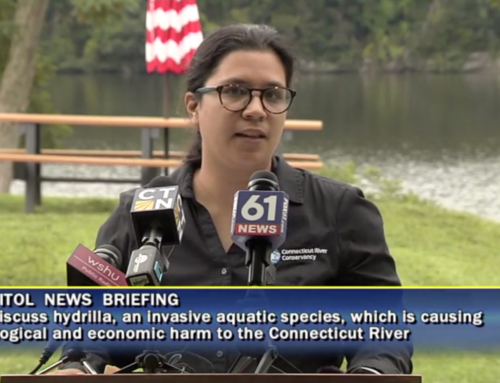Vermont, May 1, 2013. When we pave, plow for crops, mow or graze animals right up to the shoreline of a river, lake or wetland and strip off the vegetation on that ribbon of land next to any water body, we rob nature of her first line of defense in protecting human health and the water quality in the Connecticut River watershed.
A vegetative zone is the three-dimensional land area directly adjacent to the water of a wetland, lake, river or stream that interacts with both the water and land ecosystems. It serves ecological functions disproportionately large relative to its small land area. A healthy vegetative zone with a healthy duff layer of leaves and twigs on the ground slows the flow of overland runoff from rain, allowing it to be absorbed into the soil and thereby removing nitrate and phosphorus pollution, reducing pathogens, controlling soil erosion and providing food and shade for life in the water. These strips of land are especially important in reducing shoreland erosion during flood events.
When any activity destroys or diminishes the natural vegetative cover and compacts or covers the soil in this zone, nutrients and pathogens running over these surfaces, say from a parking lot, farm field or running down a lawn during rain events flow directly into a water body. If the duff of a vegetative zone does not have the chance to slow and allow for absorption, there is no treatment of the pathogens and no removal of excess nutrients. These pollutants then threaten the health of the water and human health.
Land uses that reduce the width of the vegetative zone alter the time between rain events and water level fluctuation significantly. A healthy vegetative zone allows for increased absorption of water into the soil slowing the rush of water into a water body. Absorption enhances groundwater storage and the enhanced groundwater supply increases groundwater releases back during dry times to the lake, stream or river. Without a protective vegetated area, our rivers and streams become flashy with quicker water level increases and with less storage in the groundwater meaning more likelihood of flooding events during rain events or snowmelt, and on the other side, lower water levels during dry times.
Beyond untreated pollutants reaching a water body, the loss of the vegetative zone means the loss of the in-stream habitat for all aquatic species, as well as the loss of food for the aquatic life provided by trees, leaves and branches that fall in the water. Trees, leaves, twigs and other plant material falling into the water is how the primary source of energy for our whole planet, the sun, makes its way to the base of the aquatic food chain. Without trees, bushes or shrubs near the water, there is little or no shade on the water. Direct sunlight raises water temperature and that can mean a lower level of dissolved oxygen in the water for all aquatic life. Lastly, loss of an undisturbed vegetative area denies migratory and resident birds, reptiles, amphibians and small mammal’s necessary food and shelter.
Since vegetative zones are so important to water and our health, what are the watershed states doing to protect vegetative zones. Unlike the other New England states, Vermont does not have a statewide shoreland protection law on the books. It is pretty much a wide-open situation. Although agricultural, logging, power line activities and Act 250 permits do address the issue of protecting vegetative zones, most development in Vermont happens beyond the prevue of these review processes and their minimum requirements.
How can you get involved? First, be a good steward of your own land if it has a shoreline on any of the waters in the Connecticut River watershed. Protect your water body be it a lake, stream, wetland or river by protecting the vegetative zone from removal of vegetation, compaction or paving. Leave the native plants in place.
Next, make your feelings known to the decision makers; your town planning commission, the VT Agency of Natural Resources or the NH Department of Environmental Services or the Governor of either VT or NH. Both the VT and NH Legislatures are considering legislation that will enhance protections for shorelands. NH is considering improvements to its Shoreland Protection Act while Vermont is considering adopting its first ever shoreland protection legislation. So make sure to contact your state representative. Help nature safeguard her number one tool to protect our waters, undisturbed vegetated zones.
# # #
David L. Deen, River Steward for the Connecticut River Watershed Council. CRC is celebrating 60 years as a protector of the Connecticut River.







